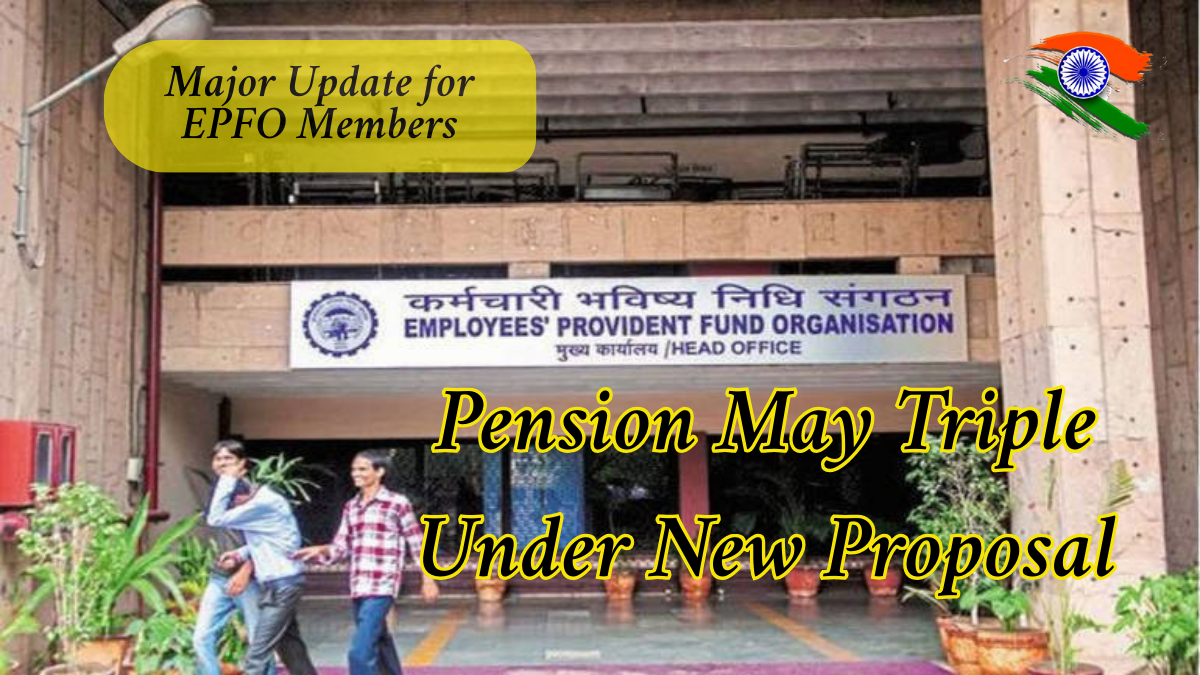In a significant development for India’s retired workforce, the Employees’ Pension Scheme (EPS) managed by the Employees’ Provident Fund Organisation (EPFO) may soon undergo a major revision. The minimum pension amount, currently fixed at ₹1,000 per month, is likely to be increased to ₹3,000, according to government sources.

This proposed threefold increase could be implemented within the next few months, offering financial relief to millions of low-income pensioners struggling with inflation.
Table of Contents
Summary Table: EPS Pension Revision Proposal

Factor |
Current |
Proposed |
|---|---|---|
Minimum Monthly Pension |
₹1,000 |
₹3,000 |
Number of Total EPS Pensioners |
78.5 lakh |
No change |
Beneficiaries of Minimum Pension |
36.6 lakh |
All to benefit from the hike |
Past Proposal |
₹2,000 (2020) — not approved |
₹3,000 — under active review |
Estimated Cost (FY24) |
₹1,223 crore |
Expected to rise substantially |
Managing Body |
EPFO |
EPFO |
Official Website |
What Is EPS (Employees’ Pension Scheme)?
The Employees’ Pension Scheme (EPS) is a social security scheme administered by the EPFO. Launched in 1995, the scheme provides a monthly pension to employees after they retire, provided they have completed at least 10 years of service.
Key Features:
- Funded from employer contribution: Of the 12% employer contribution to the EPF, 8.33% is diverted to EPS.
- Eligibility: Employees earning a salary of up to ₹15,000 per month (basic + DA) are eligible for EPS.
- Retirement age: Pension benefits are payable after 58 years of age.
Why Is the EPS Pension Increase Needed?
1. Inadequacy of ₹1,000/month
The current minimum pension of ₹1,000 was set in 2014. With inflation surging, this amount has become insufficient for basic living expenses such as food, rent, and medicine.
2. Rising Inflation
Over the past decade, the Consumer Price Index (CPI) has increased by more than 70%, yet the minimum EPS pension has not been adjusted accordingly.
3. Widespread Demand
- Multiple pensioner associations have demanded an increase.
- In 2025, many EPS pensioners urged the government to raise the pension to ₹7,500/month.
- The International Labour Organization (ILO) recommends that pensions be indexed to inflation, which EPS currently is not.
How Many Will Benefit?
According to EPFO data:
- Total EPS pensioners: 78.5 lakh
- Pensioners receiving minimum ₹1,000: 36.6 lakh
With the proposed ₹3,000 minimum pension, all 36.6 lakh minimum pensioners would benefit immediately, and the measure would bring relief to millions more indirectly through recalibration of pension slabs.
Previous Proposals and Delays
- In 2020, the Ministry of Labour submitted a proposal to increase the minimum pension to ₹2,000. It was not approved by the Ministry of Finance, citing budget constraints.
- In 2023–24, the government allocated ₹1,223 crore toward EPS pensions—a 26% increase over the previous year—indicating rising fiscal pressure.
- Current Status: The Labour Ministry is assessing the financial viability of raising the pension to ₹3,000.
Expert Opinions on the Pension Hike
Akhil Chandna, Partner, Grant Thornton:
“The proposed increase will offer much-needed stability to low-income retirees. It’s a socially responsible move.”
Sandeep Vempati, BJP Economist:
“ILO guidelines support inflation-linked pensions. Raising the minimum EPS pension to ₹3,000 aligns with global best practices and ensures dignified retirement.”
Fiscal Implications for the Government
While the move is socially and politically significant, it comes with budgetary challenges:
- If implemented, the new pension structure could require thousands of crores annually, depending on whether the government offers subsidies or restructures contributions.
- The Labour Ministry is exploring funding models to offset the impact, including increased employer contributions or central government support.
Relevance to Broader Retirement Planning in India
This development comes as India faces a growing population of senior citizens with no formal income support outside of EPFO schemes. A higher minimum pension under EPS would:
- Reduce dependency on children or social welfare programs.
- Encourage younger workers to stay within the organized sector and contribute regularly.
- Act as a stabilizing force during economic uncertainty, especially for lower-income groups.
FAQs: EPS Pension Increase
Q1. When will the new pension rates come into effect?
A: No official date has been announced yet, but the government may implement the new rates within a few months, possibly before the Union Budget 2025.
Q2. Who is eligible for the new ₹3,000 pension?
A: All EPS pensioners who are currently receiving the minimum ₹1,000 pension will be eligible.
Q3. Will current contributors see changes in their deductions?
A: Not immediately. However, if the funding structure is changed, employer contributions to EPS may increase.
Q4. Is EPS different from EPF?
A: Yes. EPF is a savings scheme with withdrawals, while EPS provides monthly pension after retirement.
Q5. Where can I check my EPS details and pension status?
A: Visit the official EPFO portal: https://www.epfindia.gov.in
Conclusion: A Step Toward Pension Justice
A potential threefold increase in the EPS pension marks a significant shift in India’s approach to post-retirement welfare. While implementation depends on budget approval and fiscal feasibility, the move—if realized—could:
- Provide dignity and financial independence to millions of senior citizens.
- Align India’s pension structure closer to international norms.
- Signal a renewed commitment to social security in an aging economy.
For now, all eyes are on the Labour and Finance Ministries, whose decisions in the coming weeks will shape the future of India’s retirees.
Click Here To Know More







